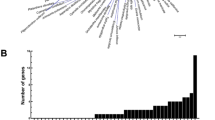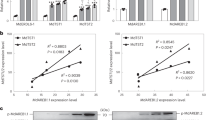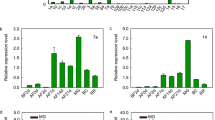Abstract
Sugar beet provides around one third of the sugar consumed worldwide and serves as a significant source of bioenergy in the form of ethanol. Sucrose accounts for up to 18% of plant fresh weight in sugar beet. Most of the sucrose is concentrated in the taproot, where it accumulates in the vacuoles. Despite 30 years of intensive research, the transporter that facilitates taproot sucrose accumulation has escaped identification. Here, we combine proteomic analyses of the taproot vacuolar membrane, the tonoplast, with electrophysiological analyses to show that the transporter BvTST2.1 is responsible for vacuolar sucrose uptake in sugar beet taproots. We show that BvTST2.1 is a sucrose-specific transporter, and present evidence to suggest that it operates as a proton antiporter, coupling the import of sucrose into the vacuole to the export of protons. BvTST2.1 exhibits a high amino acid sequence similarity to members of the tonoplast monosaccharide transporter family in Arabidopsis, prompting us to rename this group of proteins ‘tonoplast sugar transporters’. The identification of BvTST2.1 could help to increase sugar yields from sugar beet and other sugar-storing plants in future breeding programs.
This is a preview of subscription content, access via your institution
Access options
Subscribe to this journal
Receive 12 digital issues and online access to articles
$119.00 per year
only $9.92 per issue
Buy this article
- Purchase on Springer Link
- Instant access to full article PDF
Prices may be subject to local taxes which are calculated during checkout



Similar content being viewed by others
References
Giaquinta, R. T. Sucrose translocation and storage in the sugar beet. Plant Physiol. 63, 828–832 (1979).
Hawker, J. S. & Hatch, M. D. Mechanisms of sugar storage by mature stem tissue of sugarcane. Physiol. Plant 18, 444–453 (1965).
Chen, L. Q. et al. Sugar transporters for intercellular exchange and nutrition of pathogens. Nature 468, 527–532 (2010).
Lalonde, S., Wipf, D. & Frommer, W. B. Transport mechanisms for organic forms of carbon and nitrogen between source and sink. Ann. Rev. Plant Biol. 55, 341–372 (2004).
Williams, L. E., Lemoine, R. & Sauer, N. Sugar transporter in higher plants - a diversity of roles and complex regulation. Trends Plant Sci. 5, 283–289 (2000).
Moghaddam, M. R. B. & Van den Ende, W. Sweet immunity in the plant circadian regulatory network. J. Exp. Bot. 64, 1439–1449 (2013).
Winter, H., Robinson, D. G. & Heldt, H. W. Subcellular volumes and metabolite concentrations in barley leaves. Planta 191, 180–190 (1993).
Martinoia, E., Maeshima, M. & Neuhaus, H. E. Vacuolar transporters and their essential role in plant metabolism. J. Exp. Bot. 58, 83–102 (2007).
Neuhaus, H. E. Transport of primary metabolites across the plant vacuolar membrane. FEBS Lett. 581, 2223–2226 (2007).
Martinoia, E. & Ratajczak, R. in Advances in Botanical Research: The Plant Vacuole Vol. 25 (eds Leigh, A. & Sanders, D.) 365–400 (Academic, 1997).
Willenbrink, J. & Doll, S. Characteristics of the sucrose uptake system of vacuoles isolated from red beet tissue. Kinetics and specifity of the sucrose uptake system. Planta 157, 159–162 (1979).
Martinoia, E., Meyer, S., De Angeli, A. & Nagy, R. Vacuolar transporters in their physiological context. Ann. Rev. Plant Biol. 63, 163–213 (2012).
Aluri, S. & Büttner M. Identification and functional expression of the Arabidopsis thaliana vacuolar glucose transporter 1 and its role in seed germination and flowering. Proc. Natl Acad. Sci. USA 104, 2537–2542 (2007).
Wormit, A. et al. Molecular identification and physiological characterization of a novel monosaccharide transporter from Arabidopsis involved in vacuolar sugar transport. Plant Cell 18, 3476–3490 (2006).
Klemens, P. A. et al. Overexpression of a proton-coupled vacuolar glucose exporter impairs freezing tolerance and seed germination. New Phytol. 202, 115–121 (2014).
Wingenter, K. et al. A member of the mitogen-activated protein 3-kinase family is involved in the regulation of plant vacuolar glucose uptake. Plant J. 68, 890–900 (2011).
Poschet G. et al. A novel Arabidopsis vacuolar glucose exporter is involved in cellular sugar homeostasis and affects the composition of seed storage compounds. Plant Physiol. 157, 1664–1676 (2011).
Schneider, S. et al. Vacuoles release sucrose via tonoplast-localised SUC4-type transporters. Plant Biol. 14, 325–336 (2012).
Schulz, A. et al. Proton-driven sucrose symport and antiport are provided by the vacuolar transporters SUC4 and TMT1/2. Plant J. 68, 129–136 (2011).
Eom J. S. et al. Impaired function of the tonoplast-localized sucrose transporter in rice, OsSUT2, limits the transport of vacuolar reserve sucrose and affects plant growth. Plant Physiol. 157, 109–119 (2011).
Schmidt U. G. et al. Novel tonoplast transporters identified using a proteomic approach with vacuoles isolated from cauliflower buds. Plant Physiol. 145, 216–229 (2007).
Chardon, F. et al. Leaf fructose content is controlled by the vacuolar transporter SWEET17 in Arabidopsis. Curr. Biol. 23, 697–702 (2013).
Klemens P. A. et al. Overexpression of the vacuolar sugar carrier AtSWEET16 modifies germination, growth, and stress tolerance in Arabidopsis. Plant Physiol. 163, 1338–1352 (2013).
Marggraf, A. S. Zuckerrübe (Arnold Wever, Berlin 1767).
Casdorph, M. 2012 crop year review. Sugarbeet Grower 52, (1), 4–10 (2013).
Maung, T. A. & Gustafson, C. R. The economic feasibility of sugar beet biofuel production in central North Dakota. Biomass Bioenergy 35, 3737–3747 (2011).
Dohm, J. C. et al. The genome of the recently domesticated crop plant sugar beet (Beta vulgaris). Nature 505, 546–549 (2014).
Wingenter, K. et al. Increased activity of the vacuolar monosaccharide transporter TMT1 alters cellular sugar partitioning, sugar signalling and seed yield in Arabidopsis. Plant Physiol. 154, 665–677 (2010).
Zemek. J., Hricovà, D., Stremen, J. & Bauer, S. Effect of 2-deoxy-d-glucose on tissue culture of Nicotiana tabacum L. (cv. Virginia Bright Italia). Z. Pflanzenphysiol. 76, 114–119 (1975).
Kunze, H. et al. 2-Deoxyglucose resistance: a novel selection marker for plant transformation. Mol. Breed. 7, 221–227 (2001).
Carter, C. et al. The vegetative vacuole proteome of Arabidopsis thaliana reveals predicted and unpredicted proteins. Plant Cell 16, 3285–3303 (2004).
Schulze, W. X., Schneider, T., Starck, S., Martinoia, E. & Trentmann, O. Cold acclimation induces changes in Arabidopsis tonoplast protein abundance and activity and alters phosphorylation of tonoplast monosaccharide transporters. Plant. J. 69, 529–541 (2012).
Szponarski, W., Sommerer, N., Boyer, J. C., Rossignol, M. & Gibrat, R. Large-scale characterization of integral proteins from Arabidopsis vacuolar membrane by two-dimensional liquid chromatography. Proteomics 4, 397–406 (2004).
Endler, A. et al. In vivo phosphorylation sites of barley tonoplast proteins identified by a phosphoproteomic approach. Proteomics 9, 310–321 (2009).
Oldemeyer, R. K. Introgressive hybridization as a breeding method in Beta vulgaris. J. Am. Soc. Sugar Beet Technol. 18, 269–273 (1975).
Carter, J. N. Sucrose production as affected by root yield and sucrose concentration of sugarbeets. J. Am. Soc. Sugar Beet Technol. 24, 14–31 (1987).
Leigh, R. A. & Branton, D. Isolation of vacuoles from root storage tissue of Beta vulgaris L. Plant Physiol. 58, 656–662 (1976).
Boller, T. & Kende, H. Hydrolytic enzymes in the central vacuole of plant cells. Plant Physiol. 63, 1123–1132 (1979).
Reiser, J., Linka, N., Lemke, L., Jeblick, W. & Neuhaus, H. E. Molecular physiological analysis of the two plastidic ATP/ADP transporters from Arabidopsis thaliana. Plant Physiol. 136, 3524–3536 (2004).
Bergmeyer, U. Methoden der Enzymatischen Analyse (Verlag Chemie, 1974).
Stitt, M., Lilley, R.M., Gerhardt, R. & Heldt, H-W. Metabolite levels in specific cells and subcellular compartments of plant leaves. Method Enzymol. 174, 518–552 (1989).
Jung, B., Hoffmann, C. & Möhlmann, T. Arabidopsis nucleoside hydrolases involved in intracellular and extracellular degradation of purines. Plant J. 65, 703–711 (2011).
Leroch, M. et al. Identification and characterization of a novel plastidic adenine nucleotide uniporter from Solanum tuberosum. J. Biol. Chem. 280, 17992–18000 (2005).
Mühlhaus, T., Weiss, J., Hemme, D., Sommer, F. & Schroda, M. Quantitative shotgun proteomics using a uniform 15N-labeled standard to monitor proteome dynamics in time course experiments reveals new insights into the heat stress response of Chlamydomonas reinhardtii. Mol. Cell Proteomics 10, M110 (2011).
Cox, J. & Mann, M. MaxQuant enables high peptide identification rates, individualized p.p.b.-range mass accuracies and proteome-wide protein quantification. Nature Biotechnol. 26, 1367–1372 (2008).
Stanke, M., Schöffmann, O., Morgenstern, B. & Waack, S. Gene prediction in eukaryotes with a generalized hidden Markov model that uses hints from external sources. BMC Bioinformatics 7, 62 (2006).
Acknowledgements
Work in the labs of H.E.N., R.H., U-I.F. and N.S. was financially supported by BMBF (Betamorphosis). Work in the lab of R.H. and H.E.N. was additionally supported by the Deutsche Forschungsgemeinschaft (FOR1061) and the Federal State of Rhineland Palatinate (BioComp). We thank Maike Müller for technical assistance. We are grateful to Karsten Harms for supporting project planning and comments on the manuscript.
Author information
Authors and Affiliations
Contributions
B.J. conceived and conducted vacuole preparation; conceived the cloning of GFP fusion constructs and localization studies; and conducted phylogenetic analyses. B.J. and G.M. conceived, performed and analysed the expression studies. B.J., G.M. and N.W. performed sugar determination, growth experiments and generation of transgenic plants. A.S., I.M., D.G. and T.A.C. conducted electrophysiological measurements. B.P. and P.W. studied subcellular localizations. F.S., T.M. and M.S. conceived and conducted proteomic analyses. W.K. provided access to the B. vulgaris nucleotide sequences. F.L., U-I.F., N.S., I.M., R.H. and H.E.N. designed and conceived the study. H.E.N. wrote the manuscript. All authors discussed the results and commented on the manuscript.
Corresponding authors
Ethics declarations
Competing interests
The authors declare no competing financial interests.
Supplementary information
Rights and permissions
About this article
Cite this article
Jung, B., Ludewig, F., Schulz, A. et al. Identification of the transporter responsible for sucrose accumulation in sugar beet taproots. Nature Plants 1, 14001 (2015). https://doi.org/10.1038/nplants.2014.1
Received:
Accepted:
Published:
DOI: https://doi.org/10.1038/nplants.2014.1
This article is cited by
-
Genome-wide identification, evolution, and role of SPL gene family in beet (Beta vulgaris L.) under cold stress
BMC Genomics (2024)
-
Genetic diversity and genome-wide association study of 13 agronomic traits in 977 Beta vulgaris L. germplasms
BMC Genomics (2023)
-
The SnRK2.3-AREB1-TST1/2 cascade activated by cytosolic glucose regulates sugar accumulation across tonoplasts in apple and tomato
Nature Plants (2023)
-
Silicon: an essential element for plant nutrition and phytohormones signaling mechanism under stressful conditions
Plant Growth Regulation (2023)
-
Modification of Fruit Quality and Leaf Mineral Composition of ‘Nagafu No.2’ Apple Grafted onto Four Dwarfing Interstocks
Journal of Plant Growth Regulation (2023)



